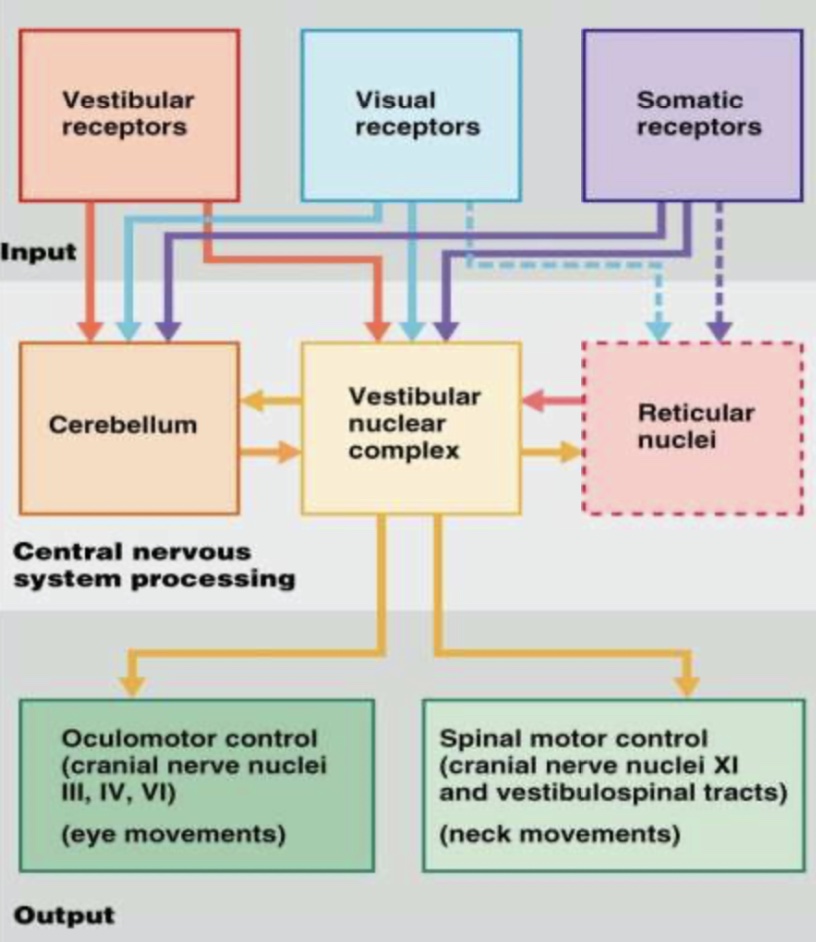
Balance and orientation
Sense of equilibrium
a) Detected by mechanoreceptors in the semicircular canals to help maintain body posture and body stability.
b) Nerve impulses generated by the receptors in semicircular canals can ales are transmitted by the vestibular nerve to Nerve VIII, and the signals will be processed by the brain.
The inner ears vestibular apparatus detects changes in the heads (and body) position in space , signaling the brain motor centers to adjust posture and maintain balance .
Equilibrium
VESTIBULAR SYSTEM
1) 3 semicircular canals , which respond to rotational acceleration , in head motion (dynamic balance).
2) saccule and utricle (macular organs) , which Respond to head tilting and linear acceleration (static balance).
Saccule and utricle are also know as the otolith organs , covered by a gelatinous layer containing small calcite crystals (otoliths) . The otoliths are covered by a fluid.
Linear acceleration (static balance)
The maculae are the sensory organs in both the saccule and the utricle. Each macula consists of Hair cells covered by a gelatinous layer containing small calcite crystals (otoliths). The otoliths are covered by a fluid. Horizontal or vertical acceleration of the head in space exerts a stronger pull on the otoliths, which are denser than the surrounding fluid. This causes the otoliths to displace the stereocilia of the Hair cells and change their receptor potential (bending stereocilia) This will stimulate the fibers of the vestibular nerve (which are attached to the Hair cells) to increase their nerve impulses according to the intensity of displacement.
Rotational acceleration (dynamic balance)
The semicircular canals are fluid – filled tubes . During any rotational movement of the head at least one canal will be active. Each canal has an ampulla, containing its sensory organ (crista ampullaris) The crista ampullaris contains hair cells whose stereocilia are embedded in the gelatinous cupula. When the head begins to rotate in a particular direction, the canal fluid initially lags behind, which shears the cupula (which is moving with the canal wall). This causes the stereocilia to bend in the opposite direction. This activates the Hair cells, causing the vestibular nerve fibers of cranial nerve VII to increase its signals to the brain to initiate motor reflexes in the opposite direction to keep balance.
Vestibulospinal reflexes
The vestibular apparatus senses positional changes, and send impulses to brain via the vestibulocochlear nerve. In the medulla, the vestibular unclei ; receive these signals and send them to the cerebellum. The cerebellum issues appropriate directions to the vestibular nuclei; which signal the midbrain motor centers to execute proper reflex movements of the head, and eye muscles. These reflexes help maintain a steady image of the surrounding objects on retina. The vestibule nuclei also signal the spinal motor nuclei to activate the appropriate postural muscles.These reflexes help maintain balance. Spinning and then stopping abruptly can cause oscillatory movements of the eye (Nystagmus)
At the end of the lesson, studends should know about
- Vestibular system and its parts
- vestibulospinal reflex
- static balance
- dynamic balance


